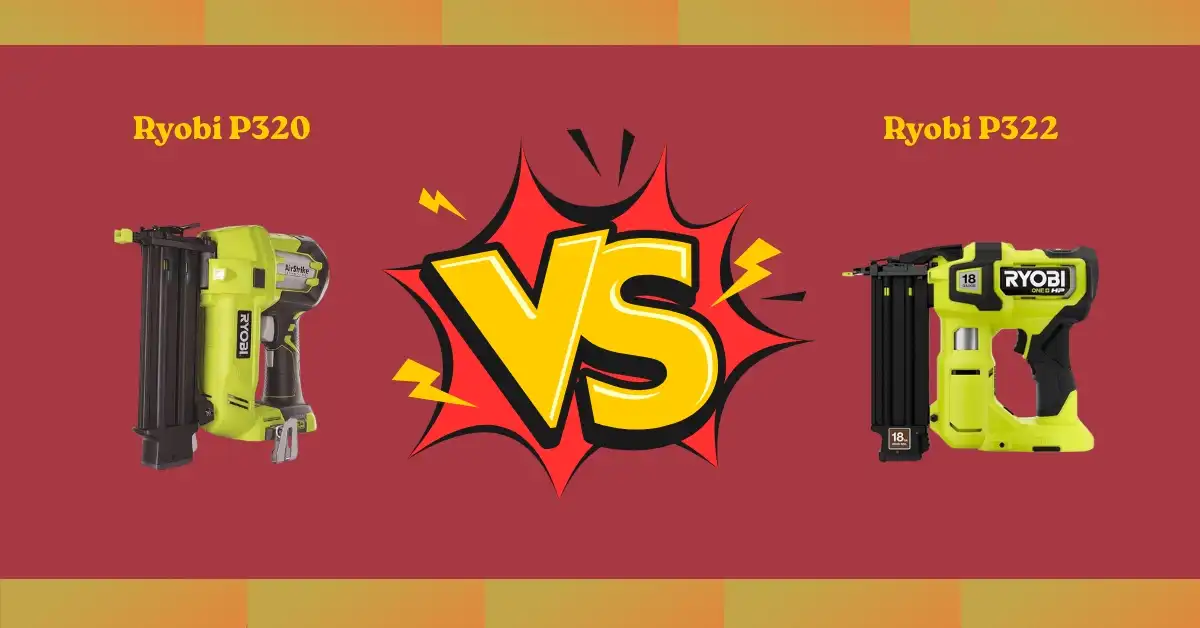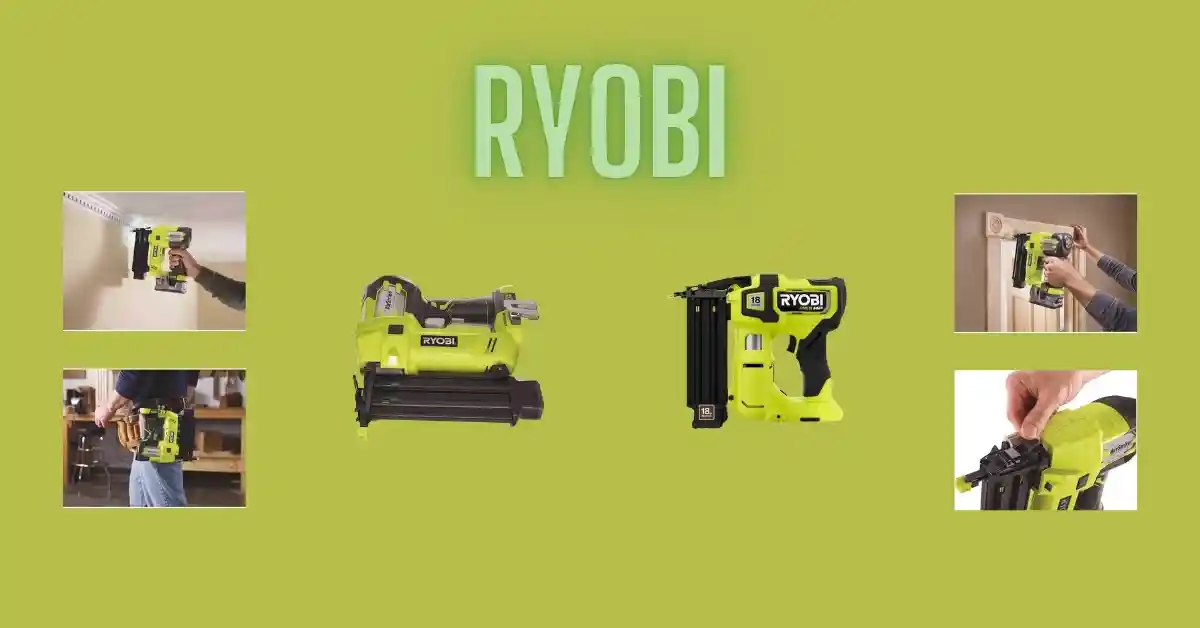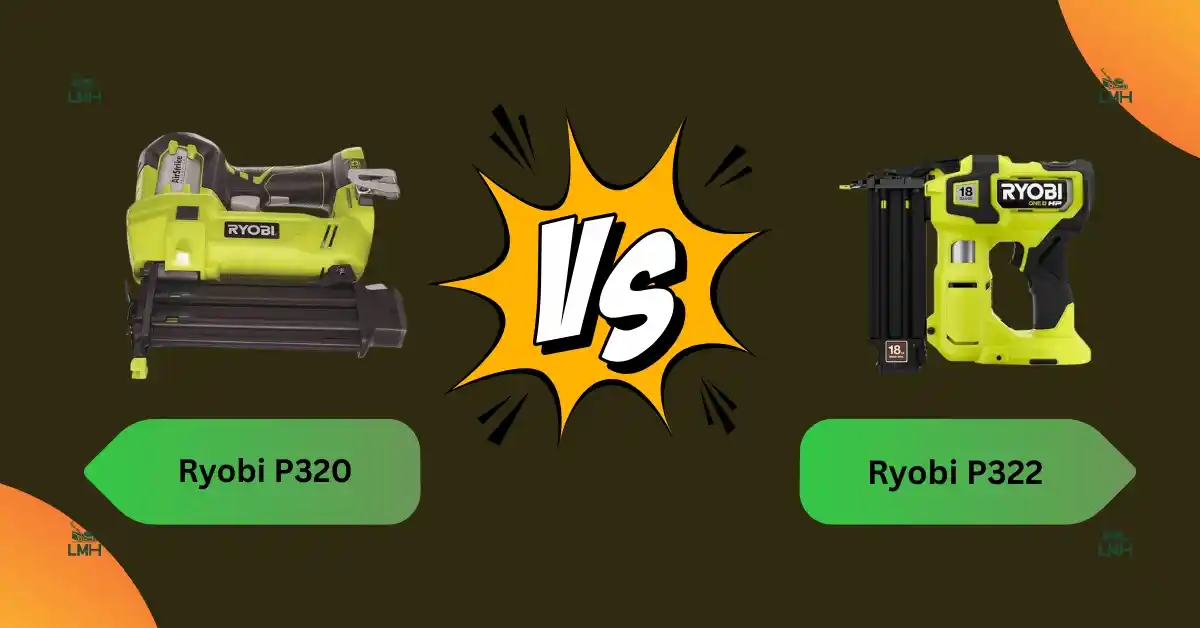Ryobi P320 vs P322 Smart Choice for Every Builder
When looking at Ryobi P320 vs P322, the real difference comes down to power and features. The P320 is simple and budget-friendly, while the P322 is stronger and built for bigger jobs. From my tool research, both have clear pros and cons that matter depending on your project. Let’s break them down so you can see which one fits your needs best.

Ryobi P320
I explored different sources to understand this product better and gather useful insights. Many users share their thoughts about how it works in real projects. By looking at reviews, feedback, and product details, it becomes clear why this nailer stands out. Here’s a breakdown of what makes it special, what could improve, and how it performs in daily use.
What is Special About This
The Ryobi P320 Brad Nailer is a tool many people enjoy using. It stands out because it makes projects easier and faster. Here are some reasons why it is often praised:
- Cordless use – No need for air hoses, compressors, or gas. You only need a charged battery.
- Strong power – Can fire up to 1700 nails on one charge.
- Easy control – The depth adjustment dial lets you choose how deep the nail goes.
- Bright LED lights – Helps when working in dark spots or corners.
- Flexible use – Works with 18-gauge nails from 5/8″ up to 2″. Great for trim, baseboards, and small wood jobs.
- High value – Many people feel it works better than pricier brands like DeWalt or Makita.
What Could Be Better
The Ryobi P320 is solid, but no tool is perfect. Here are a few things that people may notice as downsides:
- Heavy feel – At about 6 lbs (without the battery), it can feel tiring after long use.
- Nail jams – Longer nail strips may sometimes jam inside the chamber.
- Bulkier body – It is bigger than the newer P321 model.
- Battery not included – The tool-only version means you must buy the battery if you don’t already own one.
How it could improve:
- A lighter build would make it easier to hold for long jobs.
- A stronger chamber design could stop nails from jamming.
- Offering a kit with the tool, battery, and charger would help beginners.
My Personal Experience
I looked at real user reviews and expert feedback to learn more about the Ryobi P320 Airstrike. Based on that, here is what stands out in its design, performance, and build quality.
Design
The layout is simple and easy to hold. The cordless setup is a big plus since you do not need extra gear. The LED lights and depth dial add more control. Some people find it bulky, but for most projects it works well and feels user-friendly.
Performance
This nailer fires nails with speed and good force. It works well on trims, baseboards, and even harder woods. The long battery life (up to 1700 nails per charge) is a big win. A few people mention jams with long strips of nails, but clearing them is quick. For the most part, it runs smooth and steady.
Build Quality
The body feels strong and long-lasting. Many users say they have used it for five years or more without big issues. It can handle rough use and still perform. Yes, it is a little heavy, but that weight also makes it feel tough and reliable.
Ryobi P322
I explored different sources to understand this product better. Many people talk about it as a strong choice in the Ryobi ONE+ system. The P322 is a cordless 18-gauge brad nailer. It is made to give power, speed, and control without the need for air hoses or gas cartridges. This makes it easy to set up and simple to use for both DIY work and pro jobs.
What is Special About This
The Ryobi P322 stands out for many reasons. These features show why it may be helpful in daily projects.
- Cordless use – No compressor, no hoses, and no gas. It gives freedom to move and start work fast.
- AirStrike Technology – Built-in air power lets nails drive strong and steady.
- High driving strength – Can push nails up to 2-1/8 inches into hardwood. Great for trim and finish work.
- Two-point control – Separate dials for air and depth make it easy to set nails right every time.
- Quick jam release – Simple latch system clears jams in seconds.
- LED work light – Extra light helps in dark corners and low light jobs.
- Long run time – With the right battery, it can drive over 2,000 nails per charge.
What Could Be Better
The P322 has many strong points, but some parts may feel less perfect. Here are areas that users may notice.
- Weight – About 7 pounds with the battery. May feel heavy for long use.
- Bulk – Bigger than some older nailers. Can be harder in small or tight spots.
- Firing pace – Needs a reset time after each shot. Not as fast as pro-grade pneumatic tools.
- Short warranty – 90-day cover is less than many brands that give longer terms.
How it can be improved
- Use lighter parts to make it easier to hold for long jobs.
- Slim down the size for more comfort in narrow spaces.
- Add a quicker firing cycle for pros who need speed.
- Extend the warranty to give more trust in long use.
My Personal Experience
I explored many reviews and details to build a fair view of this tool. Here are notes on design, performance, and build quality that users often point out.
Design
The Ryobi P322 has a clean and simple design. The nail magazine loads fast with one button push. The two dials for depth and air are easy to use and give more control. The LED light is helpful when working in shadows. People like that it is cordless, which makes it simple to move between jobs without hoses or extra gear.
Performance
This nailer shows strong results. It can sink nails into softwood and hardwood with no problem. The AccuDrive nose gives a clear line of sight, which makes nail placement more exact. Users say nails go straight and flush most of the time. Run time is solid too. With a high-capacity battery, the tool can handle many tasks without stopping to recharge.
Build Quality
The build feels tough and made to last. The housing is solid, and parts hold up under regular use. The jam release works well and is quick to reset. The size and weight are there, but they also give a sense of strength. Many users see Ryobi as a trusted brand for tools that mix value and durability.

Ryobi P320 vs P322: Details Comparison
People who tested both nailers say they are built for different needs. The P320 is simple and low-cost. The P322 is stronger and more advanced. Both work well, but they fit different users. Let’s compare them side by side.
Design & Size: Ryobi P320 vs P322
The P320 feels bulkier and is heavier with the battery. It still has a solid grip and LED lights. The P322 is slimmer, more balanced, and has a modern look.
| Model | Design & Size | Rating |
| Ryobi P320 | Larger, older style, decent hold | ⭐ 7/10 |
| Ryobi P322 | Compact, balanced, modern build | ⭐ 9/10 |
Weight & Portability: Ryobi P320 vs P322
The P320 weighs close to 9 lbs with the battery. Long jobs may feel heavy. The P322 is about 7 lbs and sits better in hand, making it easier to carry.
| Model | Weight & Portability | Rating |
| Ryobi P320 | 9 lbs with battery, heavy over time | ⭐ 6/10 |
| Ryobi P322 | 7 lbs with battery, smoother balance | ⭐ 8/10 |
Nose Size & Precision: Ryobi P320 vs P322
The P320 has a regular nose. It works fine, but corners and tight spots can be tricky. The P322 adds the AccuDrive nose. This gives a clear line of sight and helps with precise nail shots.
| Model | Nose & Precision | Rating |
| Ryobi P320 | Normal nose, fair aim | ⭐ 7/10 |
| Ryobi P322 | AccuDrive nose, sharper accuracy | ⭐ 9/10 |
Depth Adjustment & Air Pressure Control: Ryobi P320 vs P322
Both nailers have depth settings. The P320 uses a simple dial that works well for most jobs. The P322 offers two controls, one for pressure and one for depth. This makes it easier to fine-tune.
| Model | Depth & Pressure | Rating |
| Ryobi P320 | Basic depth dial, fair control | ⭐ 7/10 |
| Ryobi P322 | Dual controls, smoother setup | ⭐ 9/10 |
Performance & Driving Power: Ryobi P320 vs P322
The P320 works great on softwood and trim. But with longer nails, it may jam or lose force. The P322 has a brushless motor. It drives nails deeper into hardwood without issue.
| Model | Power & Driving | Rating |
| Ryobi P320 | Best for light wood and trims | ⭐ 7/10 |
| Ryobi P322 | Strong brushless power, works on hardwood | ⭐ 9/10 |
Battery Life & Efficiency: Ryobi P320 vs P322
The P320 runs up to 1,700 nails per charge. The P322 lasts longer, up to 2,250 nails per charge, thanks to its brushless system.
| Model | Battery Life | Rating |
| Ryobi P320 | Around 1,700 nails per charge | ⭐ 8/10 |
| Ryobi P322 | Around 2,250 nails per charge | ⭐ 9/10 |
Jamming Issues & Reliability: Ryobi P320 vs P322
The P320 can jam, mainly with long strips of nails. Clearing it is not hard but takes time. The P322 has a tool-free jam release and jams less often.
| Model | Jam & Reliability | Rating |
| Ryobi P320 | Jams at times, manual fix needed | ⭐ 6/10 |
| Ryobi P322 | Tool-free jam release, more reliable | ⭐ 9/10 |
Ease of Use & Handling: Ryobi P320 vs P322
Both nailers are cordless and easy to load. The P320 is simple, but bulkier. The P322 feels smoother in hand and has easier controls.
| Model | Ease of Use | Rating |
| Ryobi P320 | Easy but heavier feel | ⭐ 7/10 |
| Ryobi P322 | Lighter, smoother handling | ⭐ 9/10 |
Durability & Build Quality: Ryobi P320 vs P322
The P320 has been around for years and has proven itself durable. The P322 is built tougher, with a brushless motor and solid design for heavy use.
| Model | Durability | Rating |
| Ryobi P320 | Lasts long, tested over years | ⭐ 8/10 |
| Ryobi P322 | Stronger build, brushless motor | ⭐ 9/10 |
Price & Value for Money: Ryobi P320 vs P322
The P320 is cheaper and good for casual DIY. The P322 costs more but gives more features, better life, and pro-level results.
| Model | Price & Value | Rating |
| Ryobi P320 | Low price, good for starters | ⭐ 9/10 |
| Ryobi P322 | Higher price, worth it for pros | ⭐ 8/10 |
Customer Feedback & Overall Verdict: Ryobi P320 vs P322
Users say the P320 is great for trim, home repairs, and small projects. The P322 is loved for its power and precision in bigger jobs. Both are good, but your pick depends on need and budget.
| Model | Verdict | Rating |
| Ryobi P320 | Best for DIY, small trim jobs | ⭐ 8/10 |
| Ryobi P322 | Best for pro work, heavy tasks | ⭐ 9/10 |
Final Thoughts
The Ryobi P320 is like an old pickup truck. It is simple, strong, and does the job for everyday tasks. Perfect for homeowners. The Ryobi P322 is like a modern SUV. It has more power, comfort, and tech. It is better for pros and serious builders.
For casual DIY, choose the P320. For heavy work or long projects, the P322 is worth it.
FAQ: Ryobi P320 vs P322
- What is the main difference between Ryobi P320 vs P322?
The Ryobi P320 is cheaper and good for DIY, while the P322 is brushless, stronger, and better for pro work. Learn more about their power and build. - Is the Ryobi P322 worth the higher price over the P320?
Yes, if you need more power, longer battery life, and less jamming. For light trim or DIY, the P320 is enough. Learn more about value for money. - Which is better for heavy projects, Ryobi P320 or P322?
The Ryobi P322 works better on hardwood and long nails due to its brushless motor. The P320 suits lighter wood trims. Learn more about their uses. - Do Ryobi P320 vs P322 have different battery life?
Yes. The P320 drives about 1,700 nails per charge, while the P322 handles up to 2,250 nails. Learn more about their battery efficiency and runtime. - Who should buy the Ryobi P320 vs P322?
Buy the P320 if you want a budget tool for home use. Get the P322 if you want pro-level results and stronger performance. Learn more about their fit.
Read More: Ryobi P320 vs P321: Which Cordless Nailer Offers More Value?

